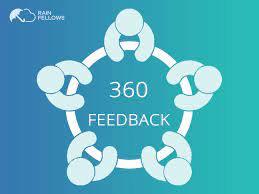Unveiling the Veil: An In-Depth Exploration of Anonymity in 360-Degree Feedback

In the intricate realm of talent development and performance evaluation, the 360 degree feedback process has become a linchpin for organisations aiming to gain a holistic understanding of an individual's capabilities. A burning question often lingers in the backdrop of this comprehensive feedback mechanism: Is 360-degree feedback truly anonymous? This article embarks on a journey to unravel the layers of anonymity in the 360-degree feedback process, exploring its nuances, implications, and the delicate balance between transparency and confidentiality.
Understanding 360-Degree Feedback
360-degree feedback is a sophisticated feedback mechanism where employees receive input from multiple sources, creating a comprehensive mosaic of insights. This mosaic includes feedback from peers, subordinates, managers, and occasionally even clients or customers. The overarching goal is to offer a well-rounded view of an employee's performance, spotlighting strengths and uncovering areas for improvement. This inclusive approach recognises the multifaceted nature of professional relationships and seeks to provide a nuanced understanding of an individual's impact within the organisational context.
The Components of 360-Degree Feedback
Self-Assessment: Individuals engage in reflective self-assessment, offering insights into their perceived strengths and areas for improvement. This introspective component encourages employees to take an active role in their professional development.
Peer Feedback: Colleagues at the same hierarchical level provide insights into the individual's teamwork, communication, and collaboration skills. This peer-to-peer perspective captures the intricacies of interpersonal dynamics within the workplace.
Subordinate Feedback: Direct reports contribute valuable input on leadership effectiveness, communication, and managerial capabilities. This component sheds light on the impact of leadership on team dynamics and employee engagement.
Supervisor Feedback: Immediate supervisors evaluate the individual's performance, offering insights into leadership competencies, goal attainment, and alignment with organisational objectives. This top-down perspective helps gauge alignment with organisational goals.
Client or Customer Feedback: External stakeholders may provide feedback, offering an external perspective on the individual's effectiveness and impact on clients or customers. This component is particularly relevant for client-facing roles.
Is 360-Degree Feedback Truly Anonymous?
The anonymity aspect of 360-degree feedback is a critical consideration that can significantly influence the effectiveness of the process. Anonymity in this context refers to the confidentiality of feedback providers' identities, ensuring that their responses are shielded from the individual being evaluated. The degree of anonymity in 360-degree feedback processes can vary, and organisations often adopt one of three main approaches:
Fully Anonymous: In this approach, the identities of the feedback providers are concealed from the individual receiving the feedback. The aim is to encourage open and honest feedback by removing concerns about potential repercussions or strained interpersonal relationships.
Partially Anonymous: In a partially anonymous system, the feedback providers' identities are disclosed to the recipient, but individual comments are not explicitly linked to specific contributors. This approach seeks to strike a balance between transparency and anonymity.
Non-Anonymous/Open: In some instances, the feedback process is entirely transparent, with both the identities of the feedback providers and their specific comments fully disclosed. This approach prioritises openness and accountability.
Implications of Anonymity in 360-Degree Feedback:
Encouraging Honest Feedback: Anonymity can create a safe space for feedback providers to express their opinions honestly, without fear of retribution. This is particularly crucial when addressing sensitive topics or providing constructive criticism.
Minimising Bias: Anonymity helps minimise potential biases in the feedback process. Feedback providers may feel more comfortable sharing candid insights without concerns about personal relationships or hierarchical dynamics influencing their feedback.
Fostering Trust: Anonymity can contribute to building trust within the organisation. Employees are more likely to engage in the feedback process if they trust that their opinions will be treated with confidentiality and fairness.
Promoting Self-Reflection: For individuals receiving feedback, anonymity allows them to focus on the content of the feedback rather than the identity of the providers. This promotes a more constructive and growth-oriented approach to self-reflection.
Balancing Transparency and Anonymity:
While anonymity in 360-degree feedback processes offers advantages in promoting open communication and honest feedback, finding the right balance with transparency is crucial. Complete anonymity may raise concerns about the legitimacy of feedback or the potential for misuse. Therefore, organisations must consider several factors to strike an effective balance:
Organisational Culture: The prevailing culture within an organisation plays a significant role in determining the level of anonymity deemed appropriate. Cultures that prioritise openness and accountability may lean towards partial or complete transparency.
Trust in the Process: The trust employees have in the 360-degree feedback process is paramount. Organisations should communicate clearly about the purpose of the feedback, how it will be used, and the measures in place to ensure fairness and confidentiality.
Nature of the Feedback: The nature of the feedback sought and the specific objectives of the evaluation may influence the level of anonymity required. For sensitive topics or developmental feedback, complete anonymity may be more suitable.
Feedback Platform: The technology used to collect and manage feedback can also impact anonymity. Some platforms allow for anonymous submissions, while others may provide varying levels of transparency.
Conclusion
360 degree feedback is a dynamic and valuable tool for employee development and performance evaluation. The level of anonymity in the process should be carefully considered, taking into account the organisational culture, trust in the process, and the nature of the feedback sought. Striking the right balance between transparency and anonymity is crucial to harnessing the full potential of 360-degree feedback
Post Your Ad Here
Comments